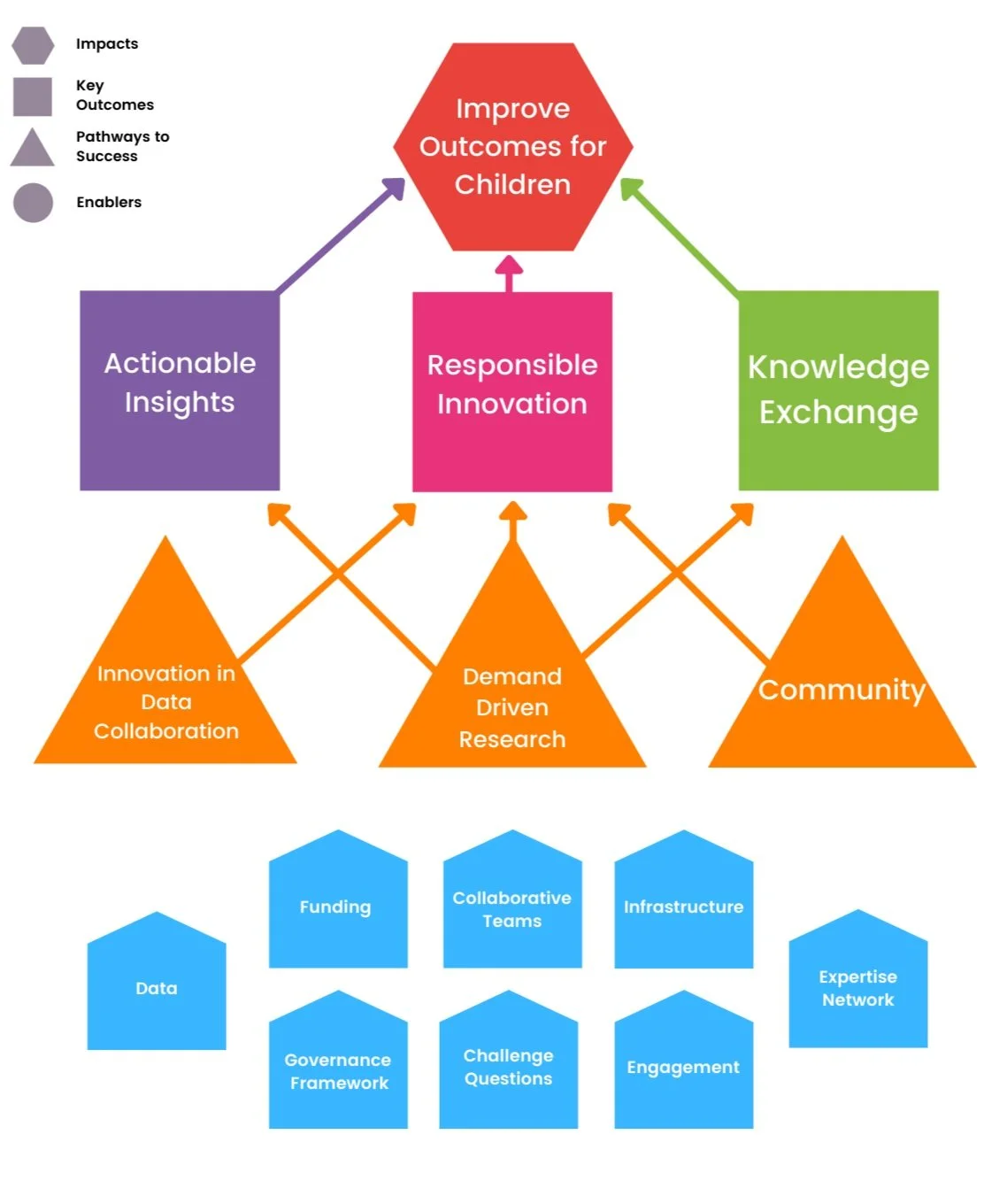Dictionary Series: What do we mean when we talk about our Theory of Change?
Demonstrating impact can be a challenge in the development and humanitarian sector, and a Theory of Change is a key bridging tool to show how change will be effective to achieve intended impact.
What do we mean when we talk about our Theory of Change?
A Theory of Change supports strategic planning and evaluation for complex initiatives. It is a way to visually and narratively describe how impact will be achieved through breaking down change activities, step-by-step.
With a vision statement of ‘Using Data Responsible to Improve Outcomes for Every Child’, we are very mindful that a legitimate question on impact that we face is “How many children’s outcomes did you improve this month / quarter / year?” But I’m sure we can all appreciate that this is an extremely difficult metric to measure and validate, particularly in the short to medium term.
A Theory of Change helps us to address this question by showing the end goal of ‘Improve Outcomes for Children’ and then breaking down the steps and activities to help us get there. Traditionally this can be categorised as Inputs > Outputs > Outcomes > Impact. But to help us better understand the activities that we were referencing in our Theory of Change we classified them as Enablers > Pathways to Success > Key Outcomes > Impact. The way we articulate this is that if we ‘push the pedals’ on our Enablers, then this will have a positive impact on the Pathways to Success, which in turn positively impact our Key Outcomes, ultimately moving us closer to our ultimate goal.
Let’s break this down further.
Enablers [Inputs]
We have a range of activities and tasks that we focus on that can be categorised under what we terms as our eight Enablers: Data | Funding | Governance Framework | Collaborative Teams | Challenge Questions | Infrastructure | Engagement | Expertise Network. This is effectively a group of what products, services and facilities you are working on that will help bring about the required outputs.
Pathways to Success [Outputs]
Our eight Enablers then map in to our Pathways to Success (multiple Enablers map to multiple Pathways to Success): Innovation in Data Collaboration | Demand Driven Research | Community. We think of this as what elements of our capacity do we need to strengthen to deliver our outcomes.
Key Outcomes [Outcomes]
These Pathways to Success then map into our Key Outcomes (again multiple Pathways to Success map to multiple Key Outcomes): Actionable Insights | Responsible Innovation | Knowledge Exchange. These can we considered as our core success deliverables to meet our vision.
How did we develop our Theory of Change?
Key for us, as a partnership, has been the fact that we could engage all of our stakeholders in the development of our Theory of Change to ensure that we were capturing the intended impact of all organisations that we seek to deliver for.
We were challenged by our board to think about how we would measure success.
Our first step was then to ask our board (and therefore our partner organisations) what success looked like to them. We conducted an ‘aspirations survey’ to all of our board members for both our strategic and operational boards to get a broad picture of the converging priorities. We assimilated this feedback into what we then termed as three pillars of success. These pillars eventually morphed into our Key Outcomes on the Theory of Change. We then drafted a list of potential indicators that were measurable which, if acted upon, would move us toward our ultimate outcomes. Following an exercise to cluster these indicators into logical groups, we then had our Enablers (or Inputs). Next we mapped the Enablers (or Inputs) up to the Key Outcomes, again through logical groupings which became our Pathways to Success (or Outputs). The language used at this stage, was again driven from the responses from the Aspiration Survey.
We then developed two visuals graphics for our Theory of Change. One, high level easy to consume diagram, that gives a summary of the model. The other has more narrative descriptions for each element, allowing for details of beneficiaries of the change activities, as well as itemising short, medium and long term impacts. This whole exercise took three to four months of iterative discussions with our boards, and a myriad of versions of the model to get consensus. Having the buy in from the internal team, the board members and being able to articulate the model very clearly to external stakeholders has really cemented the validity of the Theory of Change in being the key framework, by which we can ratify all of our activity.
What is our Theory of Change used for in practice?
Since developing our Theory of Change we have consistently found that we can easily architect all of our activities against the frame of the elements contained within. This really validates that we have chosen the right elements.
Strategic Objectives
Our one and five year objectives are all mapped under categories of our Key Outcomes
Strategic Plan
Our five year plan, which links to our strategic objectives, is again referenced against our Key Outcomes
Key Performance Indicators
We report Impact Dashboards to our boards, and each dashboard is framed around the Pathways to Success. The content of each Pathway to Success dashboard is driven by the various Enablers that feed in through our Theory of Change. This is where we are able to demonstrate that measure of success that our board asked us for in the first place.
Knowledge Zone
All of our project outputs, outcomes and impacts are catalogued in our Knowledge Zone on our website. We have again used the Key Outcomes to categorise these artefacts.
Annual Report
Our annual report was split into three sections to reflect the work delivered and impact stories from across the year.
Internal Operations Activities
In order to manage our day to day operational activities, we monitor on a weekly basis all our tasks, risks and successes based on our Enablers. It helps us monitor and manage across the team the broad range of items on our workstack into logical groupings, again validating that we have a route map as to how it ultimately aligns to our overarching goal.





